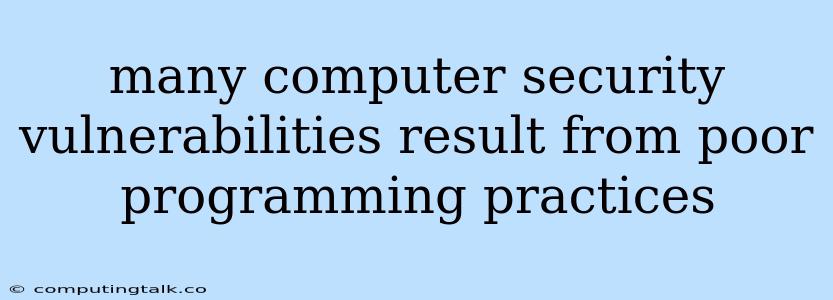The vast majority of computer security vulnerabilities can be traced back to poor programming practices. This is a significant issue, as these vulnerabilities can be exploited by attackers to gain access to sensitive data, disrupt operations, or even take complete control of a system. It is crucial for developers to understand the common causes of these vulnerabilities and to adopt secure coding practices to mitigate the risks.
What are some of the most common programming practices that lead to security vulnerabilities?
There are many ways that developers can inadvertently introduce security vulnerabilities into their code. Some of the most common include:
- Buffer overflows: This occurs when a program writes data beyond the allocated memory space of a buffer, potentially overwriting critical data or allowing attackers to execute arbitrary code.
- SQL injection: This attack occurs when an attacker inserts malicious SQL code into a data input field, which can then be executed by the database server, granting the attacker access to sensitive data or allowing them to modify the database.
- Cross-site scripting (XSS): This attack occurs when an attacker injects malicious scripts into a website, which can then be executed by unsuspecting users. This can be used to steal user credentials, redirect users to malicious websites, or even take control of the user's browser.
- Insecure authentication: Weak or poorly implemented authentication mechanisms can allow attackers to bypass security measures and gain unauthorized access to systems or data.
- Improper input validation: This occurs when a program does not properly validate user inputs, allowing attackers to inject malicious data into the system.
How can developers avoid these vulnerabilities?
There are many things that developers can do to avoid introducing security vulnerabilities into their code. Here are some key tips:
- Follow secure coding practices: Secure coding practices are a set of guidelines and techniques designed to minimize the risk of introducing security vulnerabilities.
- Use a static code analysis tool: Static code analysis tools can scan code for security vulnerabilities without executing the code. This can help to identify potential problems early in the development cycle.
- Use a dynamic code analysis tool: Dynamic code analysis tools can test the code while it is being executed, looking for vulnerabilities that may not be detectable during static analysis.
- Test for security vulnerabilities: Developers should regularly test their code for security vulnerabilities. This can be done manually or using automated tools.
- Stay up-to-date on security best practices: The security landscape is constantly evolving, so it is important for developers to stay up-to-date on the latest security best practices.
What are the consequences of poor programming practices?
The consequences of poor programming practices can be severe. They can lead to:
- Data breaches: Attackers can exploit vulnerabilities to steal sensitive data, such as financial information, personal data, or intellectual property.
- System outages: Attackers can disrupt operations by causing systems to crash or by preventing users from accessing them.
- Financial losses: Data breaches and system outages can result in significant financial losses, both directly and indirectly.
- Reputation damage: Security breaches can damage a company's reputation, leading to loss of customer trust and confidence.
Conclusion
Poor programming practices are a major source of computer security vulnerabilities. By following secure coding practices, using security analysis tools, and regularly testing for vulnerabilities, developers can significantly reduce the risk of introducing security vulnerabilities into their code.
